Eight wheel Caboose on C&Sng?
1 ...
34567



















1 ...
34567
Re: Eight wheel Caboose on C&Sng?
|
By all means, post your dissertations here, Jim. What better place? I think I've learned my lesson about opening doors number 2 and 3 when door number 1 is the point. More fun than herding cats!
I appreciate that you took the quiz... hopefully everyone got the right answers too - they just didn't write them down (chickens...). While he didn't respond to the photo essay Ron has demonstrated, with his thoughtful offer of an ex CCng boxcar as 1782, the kind of progress I hope to see here. You can read why I disagree, but still the point is he laid it on the table for all of us to consider. I ain't the last word on any of this - but I will defend what I feel is closest to the truth. And that is exactly WHY I posted the photo essay. Who can offer a reasonable dispute? I would even welcome something irrational like gittcher head outcher arsh, derrel - yer crazy! I don't want to believe and defend something just because I thunk it up. It just kinda blows my mind that I can get away with sacrilege like saying maybe the UP Annual Report was wrong and no one questions that? Yikes.... did I mention - YIKES! (and I happen to even believe it to be a real possibility). Imagine all that work and then y'all go - "Squirrel" - on me. Shhheeesh.... |
Re: Eight wheel Caboose on C&Sng?
|
In reply to this post by Jim Courtney
Grab your brake club, open the cupola end window in front of you, carefully climb onto the roof, using the lateral roof walk for best footing. Then carefully walk to the center of the caboose, braced by the wall of the cupola; using the roof walk, you carefully move forward along the top of the freight cars, stepping across the gap between cars, tying down hand brakes as you go.
A fine idea, Jim, except the window is probably frozen shut! 
Keith Hayes
Leadville in Sn3 |
Re: Eight wheel Caboose on C&Sng?
|
This post was updated on .
In reply to this post by Derrell Poole
OK, Keith, so I romanticized things a bit with a story! The point I was trying to make was that using caboose cupola windows was a common form of entry and egress from/to the caboose roof during the steam era.
Let's revisit the enlarged photo of little C&S (?) 306 that Chis posted and consider the empirical evidence: 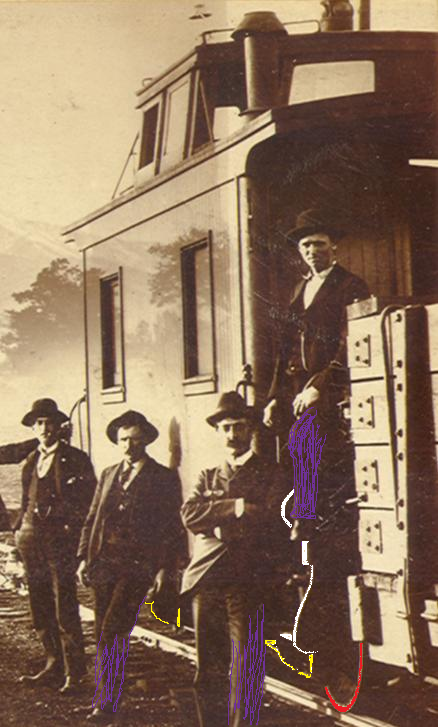 a) The cupola end window is open, slid back inboard on its upper and lower curved tracks. b) There is a little 3 board lateral roof walk on the roof, snuggled up next to the cupola end. This suggests that humans frequently stood at this spot, doing something, next to a window that opens. c) The only cupola roof grab irons are on the end edges of the cupola roof, exactly over the end window. This suggests that humans steadied themselves by holding onto it, while frequently standing at this spot, doing something, next to a window that opens. d) Finally, that damn little metal rod of a "cupola corner brace". Like you, for years I thought that it was a "structural member supporting the cupola". But was it, really? It seems awful flimsy to structurally support anything. And why, exactly, do caboose cupolas need to be supported with corner braces? Do they commonly topple forward or backward, as the slack suddenly runs in or out of the train? Are cupolas known to blow off cabooses in a high wind? Since the "corner brace" is located in immediate proximity to a grab iron over a window and next to a lateral running board where humans commonly stood, doing something, in front of a window that opens, I would submit that they are all related. The "corner brace" is actually an early version of a safety rail, to prevent a human, holding onto a grab iron, while frequently doing something, in front of a window that opens, from accidentally falling off the roof when the slack suddenly runs in or out in a moving train. Consider the following two unrelated photos: Now, that is a cupola corner brace! 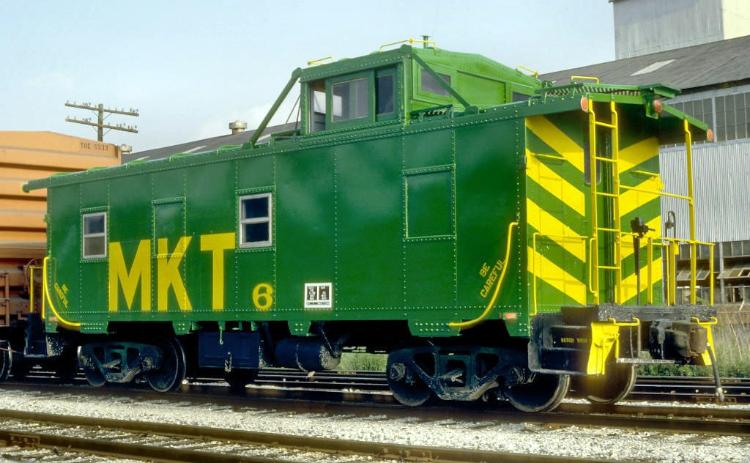 Or is it a safety rail? Note that it is located next to a lateral roof walk that is under an end window, that still slides open inboard, as late as 1971. The caboose may look modern, in her John Deere green and yellow, but she was one of the Katy's first steel cabooses, built in 1948-49, toward the end of the steam era when brakemen still roamed the roofs of freight cars. Or consider this: 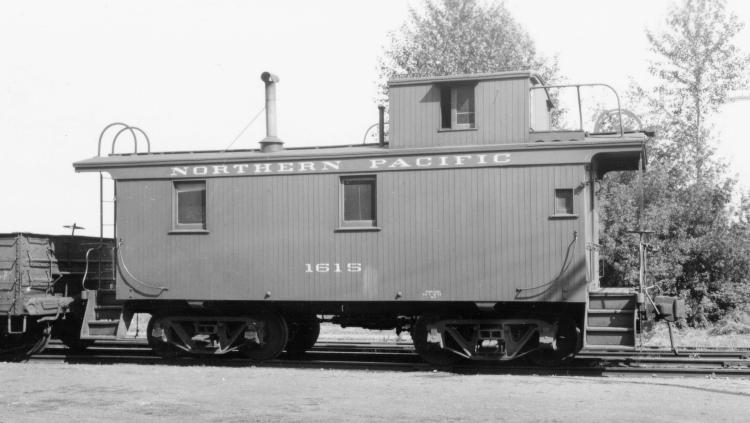 The Northern Pacific* built a whole bunch of wood sheathed cabooses during the World War 1 era; from 1920 until the early 1950s, they all looked pretty much like this. The cars had a single longitudinal running board on the car roof. They never had lateral running boards at the ends, by the ladders. The did have 2 laterals next to the cupola, one on either side of the car roof, at diagonally opposite locations next to the cupola. Erection drawings still survive and have been published. The cupola end windows over the roof walk laterals slid open inboard. As a safety measure, all NP cabooses in the steam era had a rather large safety rail mounted on each side from cupola end to caboose roof. The safety rail was in turn braced inboard to the caboose roof by a . . . well, diagonal brace. The safety rail and brace created, in effect, a "fenced" balcony, so that trainmen could enter the cupola via the end window without accidentally falling off the roof. I submit that the little metal "corner braces" on C&S 306 in 1900 were an early attempt at the same device on a much smaller scale. Derrell and Daryl, you may consider this to be Part I of my dissertation of Modeler's Notes on the First Decade C&S Caboose. Even threw in a couple of fuzzy dice! *Full disclosure: I have never been a monogamous model railroader. I grew up, literally, next to "Miss Katy" and she was the first love of my youth. Although the C&S narrow gauge is the great passion of my model railroading life, the NP will always be the standard gauge love of my life.
Jim Courtney
Poulsbo, WA |
Re: Eight wheel Caboose on C&Sng?
|
It's a good argument Jim. It has always bugged me that they put that "trip-wire" at the corner of the cupola. Some one like me (the biggest klutz any of you know) would be sure to stumble over it as I tried to circumvent the cupola. It stands to reason that one could egress from the side windows too - thus the diagonal of this "brace". In fact it occurs to me that even after end windows were closed up the cross brackets inside the cupola side windows may have been installed to stop egress after the safety rules had changed - just a thought. 1007 retained its walks around the cupola - and they went all the way around - apparently until it was scrapped about 1930. I don't think any of the others did. I've noticed that 1003 with 44 in Vol. VI only had a ladder on the B end. There is a photo of 1009 at Grant without an A end ladder as well. It is interesting to note how many trains have the B end of the caboose connected to the train and the Munnnn-KEEE TAIL.... hanging off the A end - which corresponds to these two cars without A end ladders. (There may be a "story" here, esplainnin' why 306 and 310 had B end cupolas). It may yet all make sense if we stay focused (as I ignore the fuzzy dice...)
|
Re: Eight wheel Caboose on C&Sng?
|
You've previewed Part 2 of my caboose dissertation! If I can get my @4#!*? scanner to talk to my new computer, I'm planning on posting a few more photos in the next couple of days, and discussing my take on the newly rebuilt cars, 1908-1911. No fuzzy dice next time.
Your last couple of sentences intrigue me though. Are you suggesting that the newly rebuilt cars, at least for a few years, were designated to always run "B" end first (ie ladders and brakewheel immediately next to the train and cupola always at the rear)? Interesting concept, it would require the cars to be turned at terminals and the Como Division Point. Although that would solve the problem of on which end to mount the markers. I've never figured out what the little "X" braces inside the coupola, behind only one of the (?fixed) windows were meant to do. They're a pain in the butt to remove from the Overland cars.
Jim Courtney
Poulsbo, WA |
Re: Eight wheel Caboose on C&Sng?
|
Jim, I'm not particularly suggesting anything. I said it was "interesting to note..." perhaps suggesting that we all pay attention to this - as suggestions go. It would cost a few extra moves at the terminals. I've observed that a few cars had walks partially around the cupola and ladders only on the long end. So, what does that mean? If in most cases we see that end attached to the train perhaps it means a propensity of the crews to hook up the bobber in that manner. Who knows? jim, I'm not partic |
Re: Eight wheel Caboose on C&Sng?
|
In reply to this post by Derrell Poole
Studying the fleet pics today, I see that 1007 appears to have kept it's tip-toe boards on the side of the coupola until the end. I had not spied this detail before.
I am a hobbyist and sometime historian, and have never worked a train. The diagonals look to me to be thinner than a grab iron. More of a tension member, though I have no idea why. Let's face it, at C&S speeds the coupola was not subjected to onerous forces due to wind. They are a trip hazard, not a safety device. Perhaps it reinforces the break in the roof. Most coupolas have corner roof grabs, ostensibly to help the crews negotiate their way around the coupola. while the photo shows an operable sash on the end, this seems like an easy way to invite cinders into the interior. While this might be an inviting way to ascend to the roof, I continue to believe the man door and the end ladder are the preferable route. I can understand that a brakie is on the wrong end of the car when the Hogger whistles for brakes. This would require mounting the ladder and shinning around the coupola. Not sure the rulebook says about this, but it seems to be an issue common to many lines.
Keith Hayes
Leadville in Sn3 |
Re: Eight wheel Caboose on C&Sng?
|
I said I thought Jim's arguments were good. I'm not sure they are convincing. And I don't really know what any of the braces were for. Here is one window brace inside 1009;

The particular assembly and application of these straps seem to suggest that they were meant to make the framework of the windows more rigid. I find this primus seems more logical to explain the outside diagonal irons as well - or at least the attempt to reduce the side to side motion and what it might do to the operation of the end windows. As hand grabs the diagonal braces seem awkward . Not saying the cupola windows were not used to exit the car onto the roof but those irons are just not convenient for that. If you think about crawling out of the window (belly down) why do you need to grab an iron splayed off at an angle? You may make better use of the edge of a walk board. If you hoist yourself out then a grab on top of the roof would be more convenient. As the car rolls down the rails they swayed and bobbed and twisted. Enough of this and maybe the windows don't work so good. Perhaps the irons were meant to increase the rigidity of the cupola to help reduce the operation of the windows on the ends. Maybe the braces were angled to increase their horizontal reach - their effectiveness as structural members. And maybe they were not as necessary at the short roof end as the cupola sat on top of the end wall of the body and they simply didn't make any difference. After a lifetime of structural awareness from playing with tinker toys and building blocks as a little kid to drafted for structural engineers and designing custom homes - maybe one develops a sense of what makes physical sense? Just my thoughts for what they are worth. |
Re: Eight wheel Caboose on C&Sng?
|
This post was updated on .
I'm not even sure that my argument is convincing!
All that I'm saying is the diagonal "corner braces" vs. "safety rails" only appear in proximity of the lateral roof walks. Your 304 (later 1003) only has the "corner brace" on the B end of the cupola, over a lateral roof walk. The cupola is no more than 3.5 years old, so it shouldn't need bracing from age and past motion. The fact that there is no "corner brace" at the A end of the cupola of 304, and no lateral or longitudinal roof walk, further strengthens the association of the 2 elements (but not proof of a causal relationship). The "corner braces" disappear from the cupolas after all the USSA hardware is applied by about 1915. The cupola roof grab irons, all the way around the perimeter of the roof, may have supplanted the function of the "safety rail" for the trainmen. If the "corner braces" served some essential structural function, why weren't they needed from 1915 to 1940?? But, taking the counter argument, the sides of the cupolas were pretty much all windows and little structure; as such, they would have been prone to longitudinal / diagonal sway in the plane of the side, so perhaps some sort of diagonal bracing was necessary. Perhaps the little strap metal "X's" in your picture above, supplanted a structural function of the "corner brace/safety rail". Is there a period of time when C&S caboose cupolas have neither "corner braces" nor "internal "X braces"?? Heck, you guys are the architects and engineering types--I'm just a Baby Doctor, who models what he sees and tries to make sense of it!!
Jim Courtney
Poulsbo, WA |
Re: Eight wheel Caboose on C&Sng?
|
Well, preserving the well being of babies is far more noble than this endeavor - so don't knock it. Its just a matter of a sense about some things after a bunch of "association" with vaguely similar other things. It all comes down to this - physics.
And the pursuit of what's True. What's true is that I don't know either. But after some semblance of cogitation I find it more difficult to regard the braces as grab iron. It just seems that, of all the options for placing grab irons for the safety of the crew (in the days when it took an act of Congress to force industries to consider their employees with a little more regard), that they would have chosen this particular (imo) awkward arrangement. Why not bolt a standard grab iron to the top of the walkway? I think I offered a possible explanation why there weren't corner braces at the A end of 304's cupola; it sat on top of the end wall of the caboose - inherently more rigid. We see the corner braces well before the cars were rebuilt - even before the TOC. They probably discovered quite early on that it was a matter of months rather than years that they began having window issues. Just how much movement do you need to jam a window? (Fractions of an inch, I'll wager.) Granted we don't know what interior structure was installed under the center lookouts of the pre 1908 cars but it might have been inadequate to the point that they moved the cupolas to one end or the other as a means of mitigating structural problems. (Speaking of which there is a plethora of possible structure bracing on the insides of the cars.) Perhaps the inboard corners were braced in anticipation of continuing problems with a face of the cupola not so well fixed to the car frame. After 1915 they removed the corner braces because they had taken other measures that were far more effective - perhaps including the cross braces in the side windows. But to answer your question; I don't know if there was a period with neither X braces in the windows and corner braces were used. But I kinda doubt it. As you can see there are any number of explanations we can come up with. I think this is a good thing. Unless we can find documentation to es-plain it to us we will likely never know for certain. What we have is a topic that if we batter and burse enough, we might have the ability to determine what was likely. Let us not fear to bring our little lambs to the alter for slaughter. Some of them might turn out to be golden and some of them piggies. |
Re: Eight wheel Caboose on C&Sng?
|
In reply to this post by Derrell Poole
This is a cross brace for lateral stability. No doubt (as Derrell surmises) it helps keep the window operable. The key is the fastener where the straps cross. As Jim points out, there is not much in a cupola to resist lateral forces and no doubt a bit of cable kept the whole works upright.
Keith Hayes
Leadville in Sn3 |
Re: Eight wheel Caboose on C&Sng?
|
This post was updated on .
In reply to this post by Derrell Poole
I think that I can further undermine my own argument:
Consider this photo, undated, from Narrow Gauge Pictorial VIII, Poole and Martin, Grandt Line Publications, page 125. 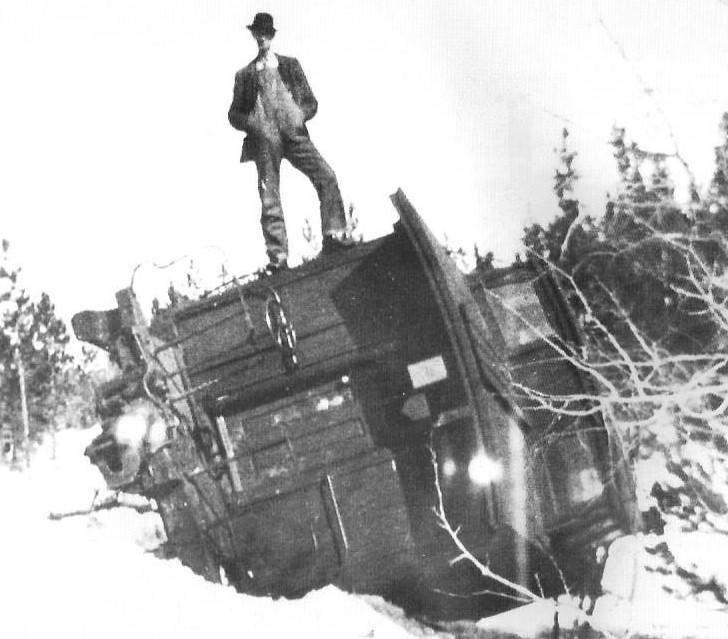 The photo is labeled "1005" but I'm skeptical, and think it may be 310 / 1008. The photo is probably later than the photos posted of 306, likely 1902-1903, judging by the automatic "Washburn" couplers. Note the four-board longitudinal roof walk. The "corner braces / safety rails" are faintly visible, and there are no lateral roof walks next to the cupola. So the two elements are not always found together. Oh well, we all end up modeling what we see, not always understanding what we see! BTW, note the lower brake staff bracket on the end sill--nice detail for model construction. You are correct, that to arrive at the "likely" (if not the "truth"), one has to sometimes abandon one's perceived "self evident truths." Over the years, I've studied every book, photo, drawing and map I could find regarding the narrow gauge C&S. I've come to consider myself an authority on the little line. But when you live in a D&RGW / RGS modeling world, being an authority on the C&S is kinda like being a scholarly monk in an isolated monastery during the Dark Ages. You end up being an expert in a crowd of one! That's why I find this Blog so important. For the first time I can easily discuss these things with other very knowledgeable people, have my ideas challenged, my pet theories rebutted and perhaps . . . build better Sn3 models. One other question: The C&S plans for the 1908 caboose rebuilds were published in an article that you did for Outdoor Railroader. They only included side and end section elevations and a floor plan. Have you ever seen true exterior elevations of the sides and ends of the same set of C&S plans from June, 1908??
Jim Courtney
Poulsbo, WA |
|
FWIW, after following this thread I’d also lean toward the braces providing the necessary stability for window functioning. It doesn’t take much out-of-squareness to keep a sliding window from moving….
Cheers, Jeff. |
Re: Eight wheel Caboose on C&Sng?
|
In reply to this post by Jim Courtney
It is a little difficult to be certain but I would agree that this car was more likely 310 if we assume the lateral walks next to the cupola were not removed from 306 in the interim. Or that this was not another car we are not certain of. Also the photo has been published many times. Not having checked every one of them I nevertheless venture that they each have their own opinion of the date it was taken. Like the locomotives we are developing a set of identifiers that help us narrow the accuracy of the dates. I think it is safe to say this photo occurred between 1902 and 1909 give or take. BTW keep in mind what I wrote for Vol. VIII included very few photo captions and I don't recall this to be one of them.
Whether a theory proves to be right or wrong - or un provable - they nearly all do one very important thing; increase discussions that help expand our understanding. I know I've learned from this one. We are compelled by meaningful arguments to focus our attention and, those of us who can, to dig into the limited knowledge base that we have - it's all good, Jim. In answer to your last question I'd like to quote from Hol Wagner in Chapter 22 - Cabooses and Official Cars - 1908, "C&S the First 10 Years" unpublished; "In 1908 the company would develop plans for a “standard narrow gauge caboose,” based on the cars then existing. Just 12 feet 11 inches long over end sills and 20 feet 5 inches long over couplers, it was truly a tiny car, with two side windows and a cupola mounted flush with one end of the carbody. Several of the rebuilds came close to matching these standard plans, but no new cars were ever built to the standard." When we speak of the 1908 rebuild (which undoubtedly went on over a period of years and likely never affected a few of the cars) we need to keep this in mind about the 1908 Standard Drawing - it was probably intended for new builds. And no, I've never seen anything more of the drawing than what was published. In fact, it occurs to me that perhaps this was one page of what would turn out to be an incomplete set and the idea of a Standard NG Caboose was basically abandoned. A possibility - not a fact. |
Re: Eight wheel Caboose on C&Sng?
|
This post was updated on .
Thanks for the info, Derrell, useful as always.
Seems par for the course for the early C&S modeler, that the only "official" C&S plans from that era to survive, turn out to be "concept drawings" rather than true erection plans. Kind'a like the C&S plans for the modern reefers with a truss rod "type 2" underframe, when the actual construction incorporated the SUF. When I use the term "1908 rebuilds", I'm referring to the process of rebuilding the cabooses that likely happened in 2-3 car batches over the course of several years. It would be unrealistic to pull all of the cabooses out of train service at one time, to rebuild them all at one time. Besides, the C&S car shops had its hands full, from 1907-1910, building the modern freight car fleet. This small batch rebuilding probably accounts for the differences (not sure classes is the right word) in the rebuilt cars that survived to the "modern era": The 303 / 1002 was already a long body car (14+ feet) by 1903, the only "rebuilding" was probably upgrading the underframe, the remainder of the car unlike any other modern caboose. The "long body" rebuilds (300 /1000, 304 / 1003 and 312 / 1009) which acquired 14+ foot bodies could have conceivably been completely new construction, the original cars so worn out that it was easier to start from scratch rather than rebuild. They possibly used the 1908 drawings for inspiration if not actual measurements. Two of the "short body" rebuilds (308 / 1006 and 309 / 1007) were virtually sisters, both with ~13 foot bodies, likely batched at the same time or sequentially, perhaps 1911-1912, due to the Folio 27 drawings: 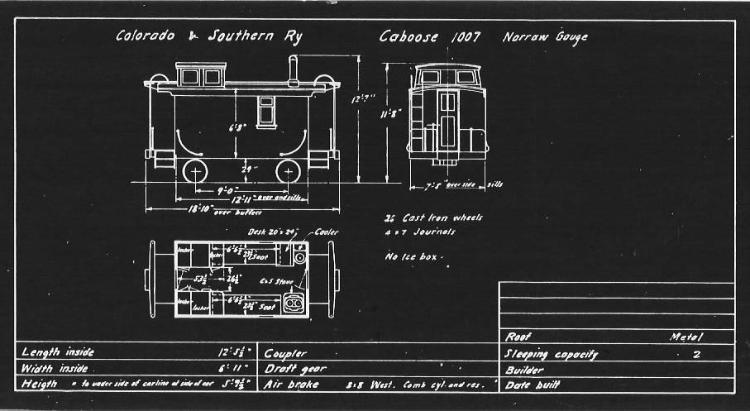 Number 309 / 1007 has been rebuilt to its modern configuration, while number 308 / 1006 has yet to be rebuilt: 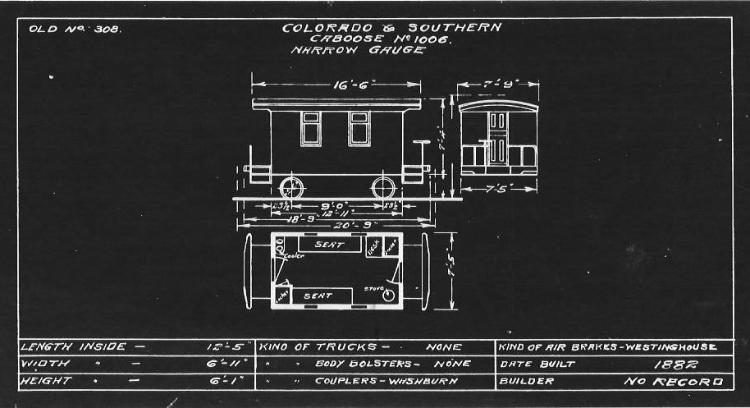 The 308 / 1006 still has its original South Park "waycar" configuration, likely the original under carriage. Finally, the 306 / 1005 and 310 / 1008 were also sisters, but different from the other two short body rebuilds due to location of cupolas, brake staffs and window location and style. I've come to thinking that these two cars were in the last batch, due to Folio 27 information: 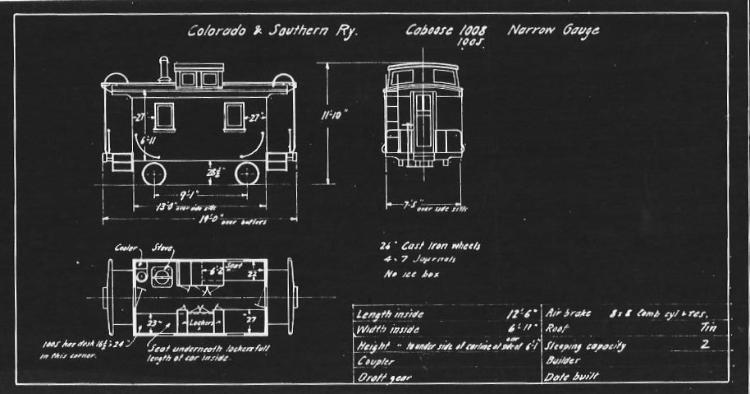 It is my understanding that the new caboose numbering scheme was devised in mid to late 1911, though the cars were not actually renumbered until February, 1912 ( I think I got this info from some guy named "Poole"). If that is the case, the Folio 27 drawings would date from mid 1911 at earliest. The drawings of 1005 and 1008 show the cars still retaining their center cupolas and early 2 window sides and I assume the original underframes, but are already outfitted with the new ladders with ringed tops in their modern locations, like the drawing of rebuilt 1007 in the same volume. This would suggest to me that these 2 cars were batch rebuilt last, perhaps 1912 or 1913. Does this reasoning hold up? Can the Folio 27 drawings be taken as an accurate look of the cabooses in 1911? I've wanted to get the Folio 27 diagrams up for those on the C&Sn3 Blog that might not have access to them. I apologize if this discussion seems redundant, I'm just restating what I think I know, so if any pigs are hiding among my lambs, I can cull them out of my thought herd! BTW, when will Hol Wagner's new tome be available for purchase?
Jim Courtney
Poulsbo, WA |
Re: Eight wheel Caboose on C&Sng?
|
Jim, thanks for the folios.
Consulting V VIII images, 1005 and 1008 are the two odd cars with respect to coupola placement relative to the B end. All other cars (save center coupola 1002) are similar in this regard.
Keith Hayes
Leadville in Sn3 |
Re: Eight wheel Caboose on C&Sng?
|
This post was updated on .
Your welcome, Keith.
BTW I still promise to post some photos of P-B-L passenger truck modifications for my Overland coaches. I seem particularly technology challenged the past couple of weeks. First the sudden need for a new computer, then a scanner that wouldn't talk to said computer and now my Nikon D-80 (that I usually use for photos of models) only blinks an ERR message when I turn it on. My household obviously needs a thirteen y/o kid!.
Jim Courtney
Poulsbo, WA |
Re: Eight wheel Caboose on C&Sng?
|
In reply to this post by Jim Courtney
Well, I've tried several times to determine when the folio drawings were devised. Perhaps someone who knows when the use of folios for RR equipment came into vogue could give us a general idea when that happened. But to determine from this particular set I have failed.
I am a professional drafter with roots in the traditional art of drafting when pin and ink were physically taken in hand and applied to Mylar and Velum - the replacement products of drafting Linen. Rule number one in drafting - the correct depiction of the drawing is important but paled to the importance of the data - that is the correctness of the numbers and notes. AND. Never draft more in the morning than you can erase in the afternoon. (Hopefully a picture that applies to the folio drawings is becoming more clear at this point.) The Folio drawings are diagrams (as you've noted) - not precision drawings. The numbers and notes are what is truly important. Since we don't know from whence the drawing came we cannot say they were not derived (traced) from earlier diagrams of similar purpose. Moreover the inconsistent practices of updating these drawings confound our efforts to date them. In some cases it looks as though a new sheet was drawn to replace an old sheet while in other cases the old sheet may have simply been updated to reflect new numbers and notes (you understand that I'm not particularly talking about a revised car number so much as a revised dimension). And then there are "missing" sheets such as those for 1002, 1010 even 1009. At least I don't have them. John Maxwell produced drawings from folio sheets that apparently came from George Lundberg but they are not in the currently available sets that I know of; they include certain data not provided on the currents set. So it would seem more than one version was floating around the RR domain at any given time. As to what happened to sheets we don't have? Were they perhaps pulled and destroyed along with cars that were retired? Or did they just never exist in the first place? I think your thoughts that cars were rebuilt as onezie - twozies holds substantial merit. Trying to determine the order in which they were rebuilt seems a tough row to hoe - we need AFEs to determine that. Still it is fun to speculate. I think we need to kinda divorce the ideas of car rebuilding from new car construction Common Standard drawings. The only common standard between the Drawing and the rebuilds seems to be the wheel base of 9 feet - more or less. It could even be that rebuilding of the existing cars began before 1908. But to my knowledge no AFEs have turned up to substantiate that. So I think there is the possibility that you are right about what cars were rebuilt together - such as 306 and 310. The two cars closest to the Common Standard were 308 and 309 so we might believe they were rebuilt together perhaps at the time the Standards were being developed. Indeed they could very well have been the examples for the drawing. I've sorta thought - without much conviction - that the long cars were later rebuilds but you offer worthy reasoning for the two B end lookouts being rebuilt toward the last. WEll... best I can do for anyone on this topic. Hol is working on illustrations and photos for the Book. The Book is huge. I once had a printout of the files of an earlier draft that measured in feet thick - and that wasn't the whole thing. Keep in mind they were printed on one side only, but still... It will someday soon be available on DVD and we have encouraged Hol to announce and advertise the book here on the Blog. It is an invaluable work in many respects but especially to understand not just the narrow gauge but the entire Colorado Road. It offers much explanation as to what happened to the narrow gauge. I've read most of it - but not all of it - it is the encyclopedia of "the Colorado Road". |
Re: Eight wheel Caboose on C&Sng?
|
... or at least the first 10 years of the C&S....
Hol's masterwork is over 2 million words long, without illustrations or photo captions. Rick |
Re: Eight wheel Caboose on C&Sng?
|
This post was updated on .
In reply to this post by Derrell Poole
I look forward to Hol Wagner's new work. Just as I have basic medical textbooks in my library, I consider Hol's The Colorado Road to be one of my three basic texts on the South Park and C&S narrow gauges, along with Mac Poor's book and Kindig's Pictorial Suplement. . ..
So, the Folio 27 drawings give us pretty vague information about the state of the C&S cabooses as well. They could date from as early as 1911, or a draftsman finally got around to annotating them as late as 1915 or so. Any details, sparse as they are, may not accurately reflect what the physical caboose actually looked like with regard to cupola location, ladder locations. Only the data: the body dimensions, wheel base and notes below are applicable to a given car, at some time over a 4-5 year period. This thread is now over 2 months old with over 115 responses, most of them full of interesting information about the C&S cabooses. Yet the more I read, the more I think about the Donald Rumsfeld quote about "the knowns, the known unknowns and the unknown unknowns". On this topic, a lot of what I had considered knowns about the early cabooses, have been refiled under the known unknown catagory. I realized last night that I know of only 9 photographs of C&S cabooses between 1900 and 1913--9 photos over a 12 year span! And none from about 1903 until 1910 at all. (He says, trying to remind himself why he chose not to model the RGS with its 12 volume encyclopedia of information). And what if one or more of the few surviving photos is a cosmic bad joke on the C&S modeler, perhaps a photo of an anomaly, with features that we then try to ascribe to all of the unseen cabooses! I guess that would be an example of an unknown unknown, and they could be many. Reconsider Derrell's photo of the 313 c1910 in Blackhawk, with its odd, poorly defined underframe: 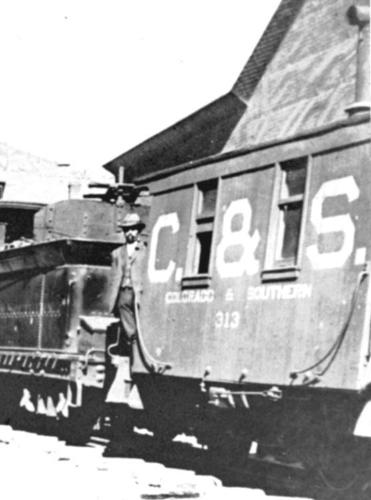 Derrell is correct, there is nothing incompatable with the original South Park waycar undercarriages and the application of air brakes. If this one photograph had not survived, no historian, railfan or modeler, from Mac Poor onward, would have ever suggested that the original caboose undercarriages had to be modified to accomadate air brake systems. Since the photo does survive, all it really tells us is how the big "C&S" mongram looked on the unrebuilt (not yet rebuilt) cabooses and that the brake cylinder attachment may have been slightly different than on later cars. I've looked and looked again at the underframe, in multiple prints (even under a surgical microscope), and I can't tell enough about it to allow any credible modeling. And so what! This could be a true-true-unrelated association: The underframe may be different on this one car due to jury-rigged repairs of wreck damage and have nothing to do with the airbrakes. Until another photo of another car turns up with the same odd underframe, I don't think one can apply this specific to the universal caboose of the era. So enough perseverating! There are no more answers! Time to build models, based on the best (only) information at hand. Absence of evidence may not be evidence, but absence of evidence can be modeler's license -- as long as it's educated specualtion.
Jim Courtney
Poulsbo, WA |
«
Return to C&Sng Discussion Forum
|
1 view|%1 views
| Free forum by Nabble | Edit this page |

